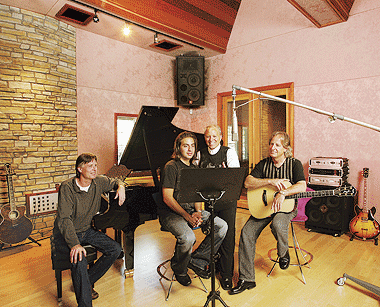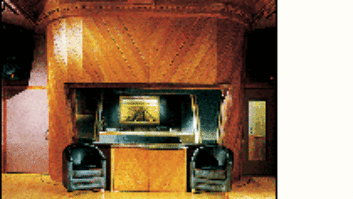

Remember high-end, no-compromise recording? Lockouts? Immersive album projects that might include, besides an old Neve, Telefunkens, Neumanns, Avalons and the like, a concierge? Now, do you also remember residential recording, from a time when places like Caribou Ranch and Bearsville were known throughout the industry for environments that promoted relaxed recording? Bill Zabit does, and he’s betting that more than a few producer/artists do also.
Way up on Sonoma Mountain, in some of the most beautiful country in the U.S., Zabit has built Sonoma Mountain Studio Estate, a Zabit/Art Kelm — designed intimate one-room masterpiece, with five-star accommodations across the road. And lest you think Zabit is banking on Madonna or the Rolling Stones to come knocking and pay for all this, he’s also teamed up with S.F./L.A. studio veteran Scott Church in Sonoma Mountain Entertainment, which focuses on artist development and promises a “new model” for the recording industry.
From left: producer/engineer Scott Church, artist Jonathan Diina, producer David Kershenbaum and owner/producer Bill Zabit.
photo: Steve Jennings
“Everybody realizes that something new has to happen in the industry,” Zabit says. “We want to be the model that others follow, and it’s already happening. The company was set up to create this venue, this studio estate that would be scalable in different areas, eventually leveraging it into a network: a vineyard estate, a mountain estate, an island estate. Then there’s the self-serving side, the entertainment company, where we find artists and produce them — there’s so much talent out there. We’re also building a catalog of material from a publishing perspective, beginning with the album I recorded with longtime music partner Joe Ripp.”
Zabit is not some naçve recording industry wannabe. He paid his dues playing bass and singing in bands for 20 years, beginning in his native Wisconsin and later touring the country and eventually getting interest from Geffen. He left all that to start an integrated marketing firm, where he specialized in communications, production, promotion, direction, advertising — a bit of everything. He was named one of Inc. magazine’s “fastest growing companies,” then sold it all in the late ’90s to pursue his lifelong dream of finding talent and owning the means of production.
Zabit scouted for locations and hooked up with equipment broker Sonic Circus in Boston to purchase an old Neve 8048. That company turned him on to Kelm, an L.A. expatriate designer/engineer living in Sonoma County.
“I wanted to create an intimate venue that was different than going into Big Studio A, B, C, through Z,” Zabit recalls of his first meetings with Kelm. “A personal studio for one artist at a time that was comfortable. Art gave me a lot of freedom to design the interior, then he did the acoustics — hard wall, soft wall. I was able to be creative with the cherry wall, what Scott calls the ‘money wall’ [pictured on the cover], how it’s leaning and faceted. I also wanted to take advantage of the height and still have structural integrity, so I came up with these two cathedral peaks of African mahogany. There are a lot of different woods in there that have different reflective values. It turned out to be acoustically magical, largely thanks to Art’s brilliance.”
While construction commenced, Zabit went after a piano, buying a 7.5-foot Grotrian concert grand from musician/store owner Mark Robertson, who turned him on to engineer Scott Church.
Church, a self-taught music business/legal type with a penchant for old-school recording methods and heartfelt singer/songwriters, had worked all around S.F. and L.A. from the early ’70s through the late ’80s. He took a hiatus to promote concerts and set up a film distribution company in Russia, but recording stayed in his blood.
“I kept recording for fun,” Church says. “I’m addicted. When Bill contacted me, I knew I didn’t want to get involved with another rich guy because I’ve been involved with many and they get bored fast. [Laughs] But Bill was a standout. I didn’t want to be simply a staff engineer again. So the main attraction was that he wanted to build a production company. He had started it; it wasn’t just talk.”
The first act signed was a young singer/musician from Buffalo, N.Y., named Jonathan Diina, soon followed by Vancouver-based international singer/songwriter Melanie Dekker. While producing tracks for Dekker, Zabit and Church received a call from producer David Kershenbaum, who had been hipped to them by Tom Menrath of GC Pro. Kershenbaum flew up, heard Dekker and signed on as co- producer (with Zabit and Church) for Dekker’s upcoming album on SME. A very good start.
The skills Zabit learned consulting to the Fortune 500 (and the Clinton White House), along with Church’s forays into other areas of the entertainment world, are skills that they plan to apply to a music industry in desperate need of reinvention.
“I always say to Scott, ‘Look at everything as an asset,’” Zabit says. “Everything we know, how we think and what we have should be leveraged into new opportunities in the new world of the music industry.”
Visit www.studioestate.com for more information.

Click here to see more photos of Sonoma Mountain Studio Estate






